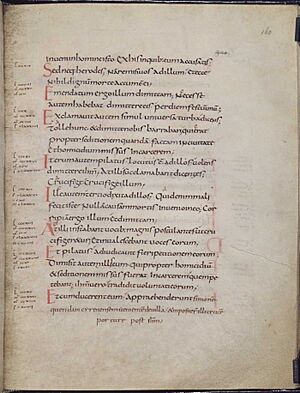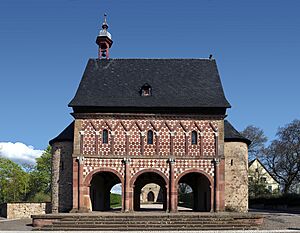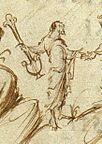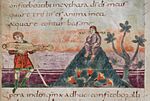Carolingian Renaissance facts for kids
The Carolingian Renaissance was a special time of learning and culture in the Carolingian Empire. It was like a "rebirth" of ideas. This period started in the late 700s and continued through the 800s. It happened during the rule of Charlemagne and his son, Louis the Pious.
People during this time looked back to the ancient Roman and Greek cultures. They also found inspiration in the early Christian Roman Empire. There was a big increase in many areas. This included literature, writing, visual arts, architecture, and music. They also improved laws and religious studies. Schools became very important. They helped create and copy many classic books. These books were both Christian and ancient Roman or Greek.
Scholars at Charlemagne's court helped lead this movement. One very important person was Alcuin of York. He wrote about many subjects. These included grammar, math, and astronomy. He also collected rare books. His love for learning made him a great teacher. Another key scholar was Theodulf of Orléans. He worked on a special edition of the Vulgate Bible.
The changes from this time mostly affected scholars and leaders. But it had a huge impact on education and culture. People worked to write better Latin. They also copied and saved old texts. They developed a new, clear writing style. This was called Carolingian minuscule. It used both capital and small letters. This writing style later influenced modern writing. This period also helped create a common language and writing style. This made it easier for people across Europe to communicate.
Contents
Why This Period Was Important
Some historians say the Carolingian Renaissance was vital. They believe it helped Western civilization survive. Before this time, Europe was not "barbaric." Important thinkers like Martianus Capella and Boethius kept ancient knowledge alive. The 600s also saw a cultural growth in Spain. Irish monasteries also spread learning across Europe. This prepared the way for the Carolingian Renaissance.
Many things helped this cultural growth. Charlemagne united much of Western Europe. This brought peace and stability. This peace led to more wealth. Western Europe's economy also started to grow again. Towns became more active. They had craftsmen, merchants, and traders. Places like Dorestad were important trading centers.
The economy grew thanks to better farming methods. Large farms produced extra grain, wine, and salt. Trading these goods helped towns expand. This economic growth was strongest from 775 to 830. During this time, many churches were built. After some difficulties from civil wars and Viking raids, the economy improved again. New fortified towns replaced older trading centers.
Scholarly Efforts and New Ideas

In the 700s, many people in Western Europe struggled with Latin. This caused problems for rulers. There were not enough people who could write for the court. Also, not all priests could read the Vulgate Bible. Another issue was that Latin was changing. Different regions spoke different forms of Latin. These were becoming the first Romance languages. It was hard for scholars from different areas to understand each other.
To fix these problems, Charlemagne ordered new schools to be created. This happened in 787. He also invited many top scholars to his court. Some of the first scholars were from Italy. These included Peter of Pisa and Paulinus of Aquileia. Paul the Deacon also came to the court. Theodulf of Orléans, a Spanish Goth, joined too. He worked on standardizing the Vulgate Bible.
The most important scholar was Alcuin of York. He was a monk from England. He led the Palace School from 782 to 796. After that, he continued his work as an abbot. Other scholars, like Joseph Scottus from Ireland, also contributed. Later, Frankish students of these scholars, like Angilbert, became important too.
The courts of Charlemagne's successors also had many scholars. Many of them were from Ireland. These included Dicuil and the famous John Scotus Eriugena.
One major goal was to create a standard plan for schools. Alcuin led this effort. He wrote textbooks and created word lists. He set up the trivium and quadrivium as the basis for education. These were groups of subjects like grammar, rhetoric, logic, arithmetic, geometry, astronomy, and music.
Another big achievement was the Carolingian minuscule. This was a new, clear handwriting style. It was first used in monasteries. It introduced the use of lowercase letters. A standard version of Latin was also developed. This Medieval Latin became a common language for scholars. It helped administrators and travelers communicate across Europe.
During this time, the idea of Europe as a distinct cultural area first appeared. This included areas that followed Western Christianity. Carolingian workshops produced many manuscripts. Over 100,000 were made in the 800s. About 6,000 to 7,000 of these still exist today. These included the earliest copies of works by famous Roman authors.
Carolingian Art and Architecture
Carolingian art lasted for about 100 years, from 800 to 900. It was a very important time. Northern Europe started to use classical Roman art styles. This set the stage for later art movements like Romanesque art and Gothic art. We still have examples of art from this period. These include beautiful illuminated manuscripts, metalwork, small sculptures, mosaics, and frescos (wall paintings).
Carolingian architecture was a style promoted by Charlemagne. It lasted from the late 700s to the early 900s. It was a clear effort to bring back Roman building styles. It copied Roman, early Christian, and Byzantine architecture. But it also had its own unique features. An example is the first church of St Mark's in Venice. It blended early Romanesque and Byzantine styles.
Many new buildings were constructed during this time. These included churches and royal homes. One expert calculated that over 500 new cathedrals, monasteries, and royal residences were built between 768 and 855.
Carolingian Money
Around 755, Charlemagne's father, Pepin the Short, changed the money system in the Frankish Kingdom. He made the system standard across the land. Smaller places that made coins were closed. The king took more control over the bigger mints. This made the coins purer.
Instead of gold Roman and Byzantine coins, he created a new system. It was based on a silver coin called a penny. This penny weighed 1/240 of a pound. The Carolingian pound was about 489.5 grams. So each penny was about 2 grams. A "shilling" was set at 11 pennies, later 12. A "pound" was 20 shillings. However, shillings and pounds were not actual coins. They were just ways to count money. For example, a "shilling" of grain meant the amount of grain 12 pennies could buy. Even though the new pennies were good quality, traders often preferred gold coins. This led to laws trying to make people accept the king's currency.
This Carolingian money system was later brought to England. It became the basis of English money for many centuries.
Images for kids
See also
- Iconography of Charlemagne
- Golden Age of medieval Bulgarian culture








